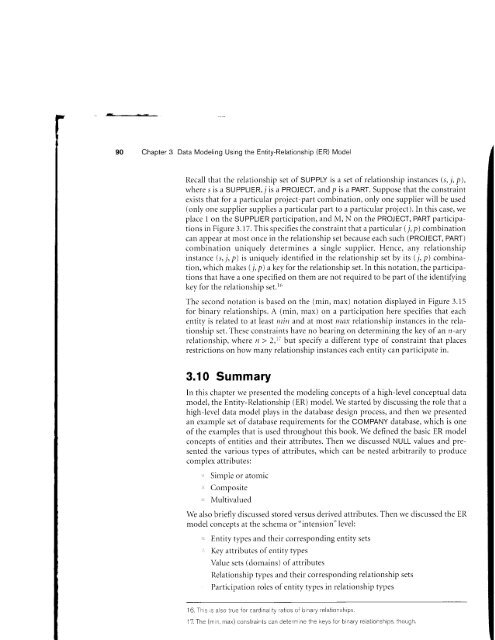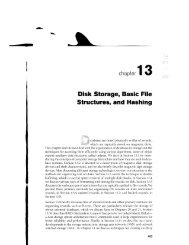this pdf excerpt
this pdf excerpt
this pdf excerpt
Create successful ePaper yourself
Turn your PDF publications into a flip-book with our unique Google optimized e-Paper software.
7<br />
I<br />
I<br />
I<br />
90 Chapter 3 Data Modeling Using the Entity-Relationship (ER) Model<br />
Recall that the relationship set of SUppLy is a set of relationship instances (t, j,p),<br />
where s is a SUPPLIER, j is a PROJECT, and p is a PART. Suppose that the constraint<br />
exists that for a particr-rlar project-part combinatior-r, only one supplier will be used<br />
(or-rly one supplier supplies a particular part to a particular project).ln <strong>this</strong> case, we<br />
place I on the SUPPLIER participation, and M, N on the PROJECT, PART participations<br />
in Figure 3.17. This specifies the constraint that a particular (j,p) combination<br />
can appear at most once in the relationship set because each such (PRoJECT, PART)<br />
con-rbination uniquely determines a single supplier. Hence, any relationship<br />
instance (s,J,p) is uniquely identified in the reiationship set by its (j,p) cornbination,<br />
which makes (j,p) a key for the relationship set. In <strong>this</strong> notation, the participations<br />
that have a one specified on them are not required to be part of the identifiring<br />
key for the relatior.rship set.16<br />
The second notatior-r is based on the (min, max) notation displayed in Figure 3.15<br />
for binary relationships. A (mir-r, max) or.r a participation here specifies that each<br />
entity is related to at least nin and at most nrax relationship instances in the relationship<br />
set. These constraints have no bearing on determining the key of an n-ary<br />
relationship, where n > 2,1; but specifl, a different type of constrait-tt that places<br />
restrictions on how many relationship instances each entity can participate in.<br />
3.10 Summary<br />
In <strong>this</strong> chapter rve presented the rnodeling concepts of a high-level conceptual data<br />
model, the Entity-Relationship (ER) model. We started by discussing the role that a<br />
high-level data model plays in the database design process, and then we presented<br />
an example set of database requirements for the COMPANY database, which is one<br />
of the examples that is used throughout <strong>this</strong> book. We defined the basic ER model<br />
concepts of entities and their attributes. Then we discussed NULL values and presented<br />
the various types of attributes, which can be nested arbitrarily to produce<br />
complex attributes:<br />
Sinrple or atonric<br />
Composite<br />
, Multivalued<br />
We also briefly discussed stored versus derived attributes. Then we discussed the ER<br />
model concepts at the schema or "intension" level:<br />
,, Entity types and their corresponding entity sets<br />
Key attributes of entity types<br />
Value sets (domains) of attributes<br />
Relationship types and their corresponding relationship sets<br />
Particil.atiorr r oles of entity types in relationship types<br />
16, Th s is a so true ior cardina ty ratios of b nary relationshtps,<br />
17 The (m n, max) constraints can determine the keys for brnary relationships, though














